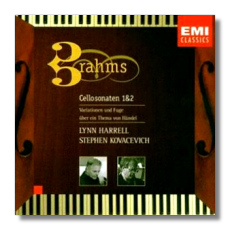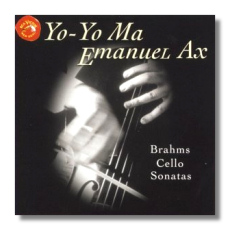
The Internet's Premier Classical Music Source
Related Links
- Brahms Reviews
- Latest Reviews
- More Reviews
-
By Composer
-
Collections
DVD & Blu-ray
Books
Concert Reviews
Articles/Interviews
Software
Audio
Search Amazon
Recommended Links
Site News
 CD Review
CD Review
Johannes Brahms

Cello Sonatas
- Sonata #1 in E minor for Cello & Piano, Op. 38 (1865)
- Sonata #2 in F Major for Cello & Piano, Op. 99 (1886)
- Variations & Fugue on a Theme by Handel for Piano, Op. 24 (1861)
Lynn Harrell, cello
Stephen Kovacevich, piano
EMI 56440


- Sonata #1 in E minor for Cello & Piano, Op. 38 (1865)
- Sonata #2 in F Major for Cello & Piano, Op. 99 (1886)
Yo-Yo Ma, cello
Emanuel Ax, piano
RCA 09026-63267 2
Every once in awhile you hear a recording and you say to yourself, "Yes! That's how this music is supposed to sound!" You have other recordings of the music in your collection, you've listened to them, too. But somehow this particular EMI recording gets it all right and you are hearing the music as if for the first time. Such was the case in this situation.
(Every once in awhile you get reality checks in life. As I put it, you learn to adjust to Life or It adjusts you. About two months after word processing the above paragraph, I received the RCA recording. Somehow the EMI review got lost in cyberspace on route to the site of my reviews. So, when the latter one came in the post, I had a chance to couple reviews. I had no idea what to expect, but was floored. I plan on just interspersing my updated comments in parenthesis between the previous ones. This may prove maddening, but what-the-hay.)
I have two other recordings of the cello sonatas: Jacqueline du Pre and Daniel Barenboim on EMI, Maria Kliegel and Kristin Merscher on Naxos 50656. The du Pre is in a special class. The Naxos recording has been in my collection for awhile, but I had not turned to it in some time. I found myself so taken with the music in this latest issue that I wondered why I had not pulled out the other discs in awhile, so I got them out.
(Brahms wrote the most beautiful chamber music I know. Even more than Mozart or Schubert, I find Brahms' music more memorable. It has an autumnal atmosphere I love. His clarinet quintet simply must be in the collection of every lover of classical music. The same is true of these sonatas. I could listen to them all night. In fact, I could alternate between these two recordings any evening.)
In the other recordings the cello is distinctively more in the fore. The piano plays almost a continuo place in proceedings. What is surprising is that Barenboim sounds so uninvolved. Kristin Merscher is more interesting. However, Kovacevich and Harrell treat the piece as equal partners. This may bother some people, but not me. It is the interplay of the instruments, a synergistic gestalt that I find attractive. Kovacevich's contributions tip the scales and in a way I like. His 'touch' is so liquid that it is a delight to the senses. Harrell's playing fits hand-in-glove with the pianist. Harrell brings a 'woody' sensation to the sound, resonating not unlike an oboe. The word "magical" is in my notes. The mood, especially in the first sonata, is definitely melancholy or autumnal. In the Naxos notes, written by Frederic Castello (and better than those in this latest EMI release) referring to the first cello sonata wrote, "The sonata makes full use of the more somber possibilities of the cello, inherent in its lower range." Certainly Harrell conveys that impression.
(You really ought to have both of these recordings. I listened to the opening five minutes of the first cello sonata by both teams. Listen to how Ma handles the music differently from Harrell. This is as good an example as I can find to demonstrate that music is more than black marks on white paper. Each man is playing the same notes, but how he plays them changes what he is playing. I have long thought that when it comes to music or any form of communication that how we say something (play it) is what we said (played). How's that for confusing parenthesis within themselves? Anyway, you really need to listen to both of these recordings, each is great in its own way and I will cherish both.)
The cellists in all three recordings do an excellent job of bringing forth that essence in the cello. I must also observe, however, that Jacqueline du Pre is an absolute magician. She gets the cello to sound like a cello and viola at the same time. I jotted down, "how did she do that?" on more than one occasion. Then, too, her interpretation is definitely an interpretation and may be too much for some people. (Also, it is, to my knowledge, not available) As I said, balances favor the cello in the other two recordings, but Lynn Harrell is certainly an integral part of the sound picture. There is only one significant differences in timings between the Naxos and this EMI recording. Kliegel and Merscher take the first movement of the first sonata at 10:14 whereas Harrell and Kovacevich take 13:56! This may be due to taking repeats, but I have no idea if that is the case. Certainly Harrell and Kovacevich don't sound sluggish. I wrote in my initial notes that 'perhaps I am somehow more ready for this music now…maybe having just finished a review of Bach's Sonatas and Partitas for solo violin has something to do with it?' Then I went on to read, in Robin Golding's EMI notes, that in the finale, "The fugue subject (surely modeled on that of the Contrapunctus XIII in Bach's Art of the Fugue)…" So, feeling a connection between the two composers was no accident on my part. Furthermore, I did not get the same feelings when listening to the Naxos recording. The sound on this EMI disc is warmer and more reverberant than on Naxos but details are not lost.
(Ma and Ax project an even more autumnal cast to the aural picture. Ma, in particular, seems deeper than Harrell. Harrell is not bad by any means, and he has moments, like at around 60 seconds into things, that his tone brings goosebumps to me. Ma sounds older and that is also apt. I slightly prefer Kovacevich's playing to Ax. Kovacevich has a liquid touch that I love. Ax is, here again, deeper sounding, his left hand is a bit more prominent, but not as fluid. Here, again, is an object lesson in the meaning of music. The resulting gestalts are educational and just damn fine music making. If I had to choose just one….no, that way lies madness. Find some way to have them both. I do wish RCA had added the same solo piano works, that would have made the RCA release even more necessary.)
Then came the 'encore'. I have never before heard the Handel Variations. This is absolutely wonderful music. If you have not heard it, either, you are in for a treat. I do not know of any pianist better than Kovacevich. I have loved his Beethoven Sonata cycle (where is the rest?). His Brahms, which I also know of from a recording of Piano Concerto #1, is equally impressive. I'd probably recommend this disc just for the Handel Variations, but the Cello Sonatas are very, very good.
On my first listening I sat through the whole disc and made only a few notes on the insert sleeve. Three times I jotted, "WOW!" That is how I think you will feel about this disc, too. While the word "wow" did not come to mind while listening to the RCA recording, I love it in a different way.
Post Script: I often read reviews where the writer will point out certain details and moments to listen for. I do the same on occasion. On the other hand, there are times when such pinpointing in a review becomes a distraction. This is not unlike reading a book previously used and underlined by the previous reader. The highlighted passages are sometimes interesting, but at others a bother. While such a practice does help develop a sense of things to listen for I am not always certain it helps you to listen. Besides, sometimes I get so overwhelmed in the actual music making that I forget to keep tabs. This happened in the case of comparing these two recordings.
And another thing: while 21 years separate these two compositions, it is amazing to me that they are so much the work of the same composer. What we hear is a change in approach, but not in maturity. Just when I am about to say that the earlier sonata is "more emotional" Ma/Ax does something that makes me hesitate to say that.
Yet another digression: Last night I spent the evening just listening to these two recordings. I made a few notes I will share with you. Ma has a touch that is different from Harrell. I cannot describe it, but I can feel it, sense it, especially in the pizzicato at the opening of the second movement of the second sonata. Kovacevich's way with the piano is more fluid, as Ax plays the opening of the second sonata, the sound has an almost salon-like quality to it whereas Kovacevich flows. Ax's left hand is a touch more prominent than is Kovacevich's. I listened to the Ma/Ax recording first, then the Kovacevich/Harrell. After that I turned the stereo off and let the music resonate the rest of the evening.
Copyright © 1999, Robert Stumpf II


















